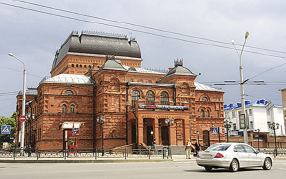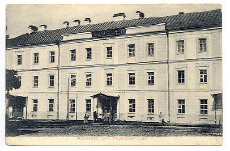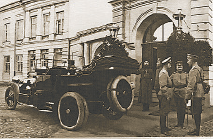The city of Mogilev has a special place in the biography of the last Russian Tsar, Nicholas II. After being established on the front line at Baranovichi in 1915, the Supreme High Command General Headquarters of the Russian Army moved to the city where it spent the next two and a half years. The Emperor returned here in March of 1917 after his abdication. His family and commanders shared his nomadic life, with all its burdens, for the good of the country.

Nicholas II was a frequent visitor to the Mogilev Drama Theatre
The First World War and the Mogilev period were rarely mentioned during the Soviet era, but recently there has been growing interest in its partially forgotten history. Local travel agencies have developed trips to the places where Nicholas II liked to walk with his wife and children. As it happens, the route could include any of the old Mogilev streets, although there are few buildings from the time remaining: the St. Nicholas Monastery Complex, the Drama Theatre, and the Polykovichi well are worth a visit. Nothing remains of the Governor’s house on Glory Square where the monarch once lived, but today, the district court building is a museum of local history. It was here, that having refused the rank of Tsar, Colonel Romanov said goodbye to his generals and people.
Some questions remain unanswered, where did the imperial train actually stand for instance? The townspeople have several theories. The well known Mogilev historian and writer Nikolay Borisenko, researched many archives during the preparation of his book about the Second World War, and questioned the oldest residents. He found that the imperial branch of the railway stretched for 400 metres from the Shklov railway crossing along the May Day Street, up to the current area of private houses.

Mogilev during the First World War. Early 20th century
There remains evidence close by, around the area where the water tower still stands, was once a firing range. On this land, near to the railway station, new small armaments, gas masks and flame-throwers were tested. The Emperor himself was photographed against the background of the tower.
In the vicinity of Mogilev today there are almost fifty places where the last Russian Tsar visited. The village of Saltanovka is known for being the site of the French defeat by General Raevsky during the war of 1812. Historian Borisenko, after reading Nicholas II’s personal diary, noted that the Emperor and his son Alexey had themselves enjoyed excavating the battleground there. He interviewed an elderly resident of the city who had been a student at the gymnasium at the time. The young man wrote that local residents were anxious about the best place to hang out a welcoming poster for the Emperor. Considering that the prison was the first big stone building on the way from the station, they decided it was the best place to put a poster with the inscription ‘Welcome!’

Mogilev. The District Court where Nicholas II abdicated the throne. Early 20th century
On a more serious note, the protection of the city in 1915-1917 was impressive. Mogilev, having been established as the nerve centre of the Russian Army, was turned into a closed city. It was surrounded by a triple-ring of gendarme military posts. Near one of them, at the Gai settlement seven kilometres from the city, today it is possible to see the remains of trenches from the period. Air defence was also developed here.
According to the recollections of contemporaries, General Mikhail Alexeev, the Emperor’s main strategic military adviser, declared that the day that Grigory Rasputin arrived in Mogilev would be the day of his resignation. This argument must have held more sway than that of the wishes of the Tsarina Alexandra Fedorovna, as Rasputin was certainly never admitted to the headquarters.
As a researcher, Borisenko was also interested to locate the cemetery containing the remains of soldiers who’d died in the local hospitals and infirmaries. It appears that it was near the road to Bobruisk. Today, in its place is an industrial zone and the highway that was laid almost 50 years ago.

In the Imperial Supreme High Command General Headquarters of the Russian Army
Perhaps one of the most exciting questions for the present generation is what sort of a man was Tsar Nicholas II? Borisenko recognises him as a person and head of his family, and for this, the last Russian emperor was worthy of respect. He loved his wife and children selflessly, and certainly felt the same about Russia. He respected the opinions of other people. The label ‘bloody’ which Soviet ideology gave him in connection with the events of 1905 does not fit in any way. The sympathy and affection of the Tsar became one of the reasons that propagandists and saboteurs attacked the army and the state. All these points created the preconditions for the October Revolution of 1917. And following this, the civil war broke out which divided families and native people as friends and enemies for such a long time.
Postcards from Vladimir Lihodedov`s collection











